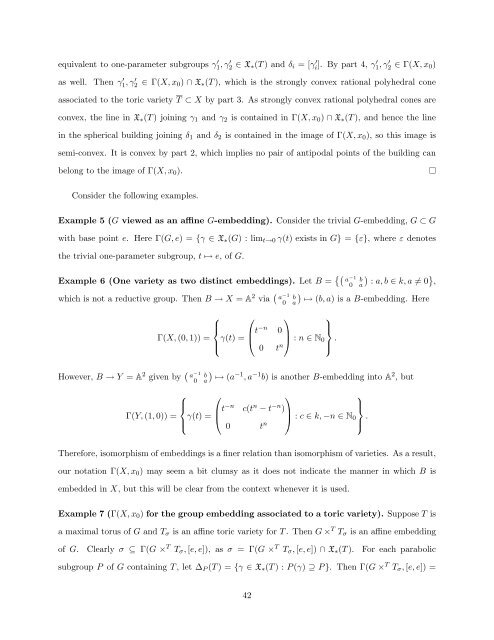Equivariant Embeddings of Algebraic Groups
Equivariant Embeddings of Algebraic Groups
Equivariant Embeddings of Algebraic Groups
You also want an ePaper? Increase the reach of your titles
YUMPU automatically turns print PDFs into web optimized ePapers that Google loves.
equivalent to one-parameter subgroups γ 1 ′ , γ′ 2 ∈ X ∗(T ) and δ i = [γ i ′]. By part 4, γ′ 1 , γ′ 2 ∈ Γ(X, x 0)<br />
as well. Then γ 1 ′ , γ′ 2 ∈ Γ(X, x 0) ∩ X ∗ (T ), which is the strongly convex rational polyhedral cone<br />
associated to the toric variety T ⊂ X by part 3. As strongly convex rational polyhedral cones are<br />
convex, the line in X ∗ (T ) joining γ 1 and γ 2 is contained in Γ(X, x 0 ) ∩ X ∗ (T ), and hence the line<br />
in the spherical building joining δ 1 and δ 2 is contained in the image <strong>of</strong> Γ(X, x 0 ), so this image is<br />
semi-convex. It is convex by part 2, which implies no pair <strong>of</strong> antipodal points <strong>of</strong> the building can<br />
belong to the image <strong>of</strong> Γ(X, x 0 ).<br />
Consider the following examples.<br />
Example 5 (G viewed as an affine G-embedding). Consider the trivial G-embedding, G ⊂ G<br />
with base point e. Here Γ(G, e) = {γ ∈ X ∗ (G) : lim t→0 γ(t) exists in G} = {ε}, where ε denotes<br />
the trivial one-parameter subgroup, t ↦→ e, <strong>of</strong> G.<br />
Example 6 (One variety as two distinct embeddings). Let B = {( a −1 b<br />
0 a<br />
)<br />
: a, b ∈ k, a ≠ 0<br />
}<br />
,<br />
which is not a reductive group. Then B → X = A 2 via ( a −1 b<br />
0 a<br />
)<br />
↦→ (b, a) is a B-embedding. Here<br />
⎧ ⎛ ⎞ ⎫<br />
⎪⎨<br />
⎪⎬<br />
Γ(X, (0, 1)) =<br />
⎪⎩ γ(t) = ⎜<br />
⎝ t−n 0 ⎟<br />
⎠ : n ∈ N 0 .<br />
0 t n ⎪ ⎭<br />
However, B → Y = A 2 given by ( a −1 b<br />
0 a<br />
)<br />
↦→ (a −1 , a −1 b) is another B-embedding into A 2 , but<br />
⎧ ⎛<br />
⎞<br />
⎫<br />
⎪⎨<br />
⎪⎬<br />
Γ(Y, (1, 0)) =<br />
⎪⎩ γ(t) = ⎜<br />
⎝ t−n c(t n − t −n ) ⎟<br />
⎠ : c ∈ k, −n ∈ N 0 .<br />
0 t n ⎪ ⎭<br />
Therefore, isomorphism <strong>of</strong> embeddings is a finer relation than isomorphism <strong>of</strong> varieties. As a result,<br />
our notation Γ(X, x 0 ) may seem a bit clumsy as it does not indicate the manner in which B is<br />
embedded in X, but this will be clear from the context whenever it is used.<br />
Example 7 (Γ(X, x 0 ) for the group embedding associated to a toric variety). Suppose T is<br />
a maximal torus <strong>of</strong> G and T σ is an affine toric variety for T . Then G × T T σ is an affine embedding<br />
<strong>of</strong> G. Clearly σ ⊆ Γ(G × T T σ , [e, e]), as σ = Γ(G × T T σ , [e, e]) ∩ X ∗ (T ). For each parabolic<br />
subgroup P <strong>of</strong> G containing T , let ∆ P (T ) = {γ ∈ X ∗ (T ) : P (γ) ⊇ P }. Then Γ(G × T T σ , [e, e]) =<br />
42
















